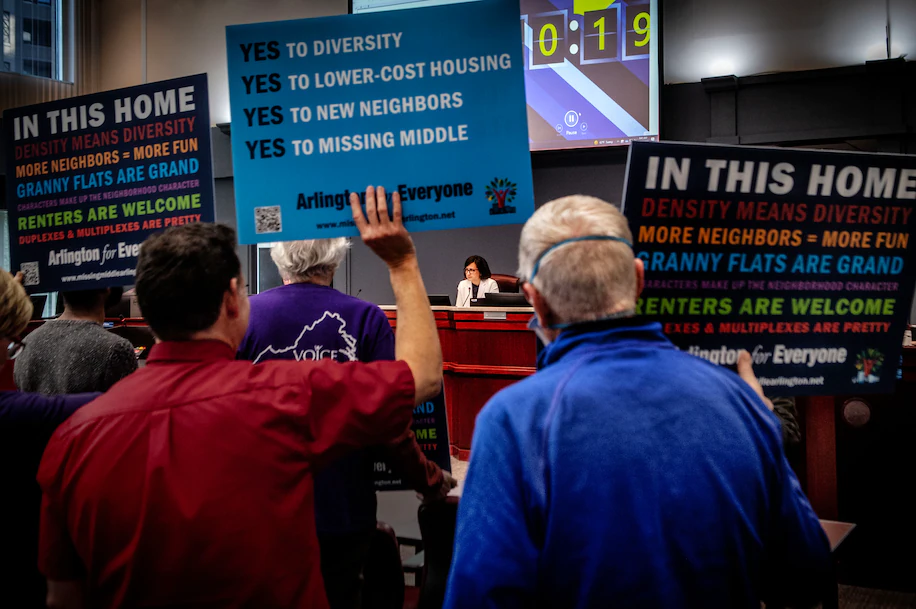Single-Family Zoning and Housing Diversity
They're all made out of ticky tacky. And they all look just the same

Teo Armus’ WaPo report “The battle over single-family zoning is also a fight over what to call it” is filed under Virginia Politics because that’s his beat but it’s really a national story. Parsing out the local anecdotes, we get this:
Like a growing number of U.S. cities and counties, this wealthy, inner-ring D.C. suburb has been ensnared in a fiery debate over whether to reconsider its zoning rules. The tentative changes would allow townhouses, duplexes or garden apartments on any residential lot, including thosereserved for only one detached house.
Similar proposals have elicited controversy almost everywhere they have been discussed. From Minneapolis to the California state legislature to Montgomery County, Md., civic groups and elected officials have clashed — sometimes in nasty terms — over whether such an effort might diversify or destroy their neighborhoods.
But that louder, more consequential debate over exactly what might happen under this policy has been belied by a less visible question: what, exactly, to call it.
Is it adding “missing middle housing,” as Arlington planners assert? Ending single-family zoning, as skeptics like Duston argue? Yielding “gentle density” or legalizing “stickplexes”?
Armus has a degree in Urban Planning from Columbia so this is a passion project for him. But, of course, as with most debates over language, the answer is Yes. One man’s “legalizing stickplexes” is another’s “missing middle housing.” All of the proposals in question would end single-family zoning but none would ban single-family housing.*
The answer stands to mold public opinion on the idea, determining if and how Arlington lawmakers can move forward — and shape whether it can take root elsewhere, too.
“All the emotions come out with zoning,” said Jason Jordan, the public affairs director at the American Planning Association. “We have to be sensitive and try to find a vocabulary … that avoids the technical jargon debate or this very polarized culture-war debate over whether the suburbs are good or bad.”
Even Jordan’s organization, which supports proposals like the one before Arlington, has not settled on one specific phrase. “People who have agendas in this space are smart,” he added, “and they’re choosing frames and language that help advance their point of view.”
That’s politics. And emotions run high because the “best” policy really depends on where you sit.
If you’re on older, established resident of a community, it’s generally in your interest to oppose change. For generations, now, American suburbs have tended to have a unified character, with all of the houses of a similar type and price range. Changing that can radically alter the character of a neighborhood.
This isn’t just a function of rich, white folks wanting to keep those of lower social strata out, either. The emotions as just as high when established Black and Latino neighborhoods start getting “gentrified,” with richer folks buying properties and either tearing them down or renovating them in such a way to make the existing houses look shabby. Inevitably, this leads to more of the same, pricing out the folks who view the neighborhood as their own.
Advocates say expanding housing supply would open expensive enclaves to more people, undoing policies once meant to keep out people of color. Opponents express concerns the changes would overwhelm local infrastructure and spoil what made these areas so attractive in the first place.
Both of these things can, and likely are, true simultaneously. For those wanting to get into a neighborhood to be close to work or various amenities, affordable options are paramount. For those already in, more people equal more congestion, drain on resources, and the like. If million-dollar mini-mansions are the norm, up-and-comers will want lower-cost options. For those in the mini-mansions, townhouses and apartments are “blight.”
In a polarized America, political disputes that veer into the linguistic are nothing new: Advocates for or against abortion rights have long labeled themselves “pro-life” or “pro-choice.” Opposite camps in the immigration debate have sparred over whether to call some immigrants “illegal” or “undocumented.”
But as a similar dynamic creeps into the technical, somewhat obscure realm of municipal zoning, a growing war about these words shows just how charged — and how widespread — the debate has become, even and especially in areas that lean overwhelmingly Democratic.
This is not shocking. Democrats are people, too. Even those who want to craft policies to help the disadvantaged often don’t want to do so to their own disadvantage. NIMBYism isn’t by any means a Republican-only phenomenon.
[72-year-old Diane] Duston, a retired real estate agent who owns a five-bedroom Cape Cod in Alcova Heights, said she talks with her neighbors about Arlington “ending single-family zoning” because it more clearly communicates how the county’s plan might affect older houses in the neighborhood.
“It hits people where they live,” she said. “They can easily visualize the house next door being torn down and a multiunit building going up [and the increase in] cars or people associated with it.”
In October, the median home price in Arlington was $650,000, and nearly double that — $1.17 million — for a single-family house. But Duston maintains that for younger people with realistic expectations, there are plenty of attainable options on the market.
Single-family zoning has for decades been the bedrock of American suburbia, and undoing it, she added, might mean fewer empty parking spots, more crowding on roads, and fewer trees to offer shade and green.
Jenny Schuetz, an urban economist and senior fellow at the Brookings Institution, said that “ending single-family zoning” is an imprecise way of describing the change — and it’s one that can mislead people.
“’Ending single-family zoning’ — that doesn’t tell you what it’s going to turn into,” said Schuetz, who has expressed support for Arlington’s plan. “Is this going to turn into a neighborhood where you’re allowed to build single-family and duplexes, or where you can build single-family, duplexes and skyscrapers?”
Again, both are right.
My 23-year-old stepdaughter lives in Arlington, so it’s absolutely doable for a young person to live there. But she lives in a high-rise apartment complex, not a $1.5 million single-family home. Crucially, said building is situated among other high-rise buildings in a walkable mixed-use downtown area, not in a neighborhood with single-family homes.
And, yes, “ending single-family zoning”—which began as the preferred language of those who wanted to do so, not its opponents—is imprecise, in that it doesn’t detail the alternatives. But, honestly, while I’d much prefer it to a skyscraper, I don’t want a duplex next to my single-family home, either.
When Minneapolis officials first proposed a plan similar to Arlington’s in 2018, they framed their effort as one that would allow new multifamily types of housing in every neighborhood. Concerned residents ginned up opposition with red yard signs that warned, “Don’t Bulldoze Our Neighborhoods.”
Yet, it was local advocates for the policy, Schuetz notes, who doubled down on the idea of the plan “ending” Minneapolis’s single-family zoning.
One local group of urbanists created a meme in the style of a retro national parks ad, with a cartoon beaver: “Remember: Only you can prevent sprawl. Help keep America green. End single-family zoning.”
But, of course, these are people who want to end the suburban lifestyle altogether. They absolutely have a point: in addition to equity issues, it’s a really inefficient way to organize our lives. It’s a huge resource drain to live that way. Everything from supplying utilities to picking up trash to maintaining roads is much more expensive. And that’s to say nothing of the wastefulness of lawns.
Still, a lot of us really, really like it and will fight to keep that lifestyle.
When Arlington County planners launched a multiyear study in 2019 to consider how to solve the county’s housing crunch, they instead chose to call their initiative “missing middle housing.”
The term was coined by the Berkeley, Calif., architect Daniel Parolek to describe the housing types that did not exist under many cities’ zoning codes: townhouses, small apartment buildings and much more.
“The reason we created this concept was to effectively frame the conversation about this need for these housing choices,” said Parolek, who presented it at an Arlington event in 2016, “without using terminology that comes with some baggage.”
But the mere effort to study the idea immediately generated concern among Arlington civic leaders, who feared it would mean “ending single-family zoning,” even as some county board members insisted that was not yet on the table.
Introducing academic jargon into policy debates almost never ends well. People won’t understand it and those using clear language will have the upper hand.
Three years later, with those changes on the horizon, skeptics of the policy — as well as some of its proponents — maintain that the phrase “missing middle” has mucked up some of the public conversation.
“I don’t think there’s a missing middle,” said Duston, the Alcova Heights homeowner. Although most of Arlington’s residential land is reserved exclusively for single-family homes, she pointed out that other neighborhoods are filled with duplexes and townhouses.
For residents who are not closely tuned-in, Duston added, the label seems to point toward creating housing for a different middle: the middle class.
For a variety of reasons, I’ve lived in way more places than most folks. I’ve never lived in a high-rise apartment, because, while I’ve worked in a major urban center (DC), I’ve never lived in one. (I lived for seven years in Houston as a kid but we were in a decidedly suburban-style neighborhood.) Still, I’ve lived in apartments housing eight families, townhouses housing four families, duplexes housing two, and lots of single-family homes. To the best of my recollection, all of these have been in like communities. That is, when I lived in apartments, all of the housing in the area was essentially exactly the same. When I lived in a duplex, so did everyone else in the neighborhood. Ditto the townhouses and single-family homes. I don’t recall that ever being a problem and see it as the “normal” state of affairs.
[25-year-old Grace] White, who canvasses with the group YIMBYs of NOVA, often sets up a whiteboard at the farmers market asking passersby to mark down what types of homes they’ve lived in: high-rise apartments, detached single-family houses, and everything in between.
A renter who splits a two-bedroom in Westover, she said that Arlington officials have had “a little bit of trouble” trying to figure out how to phrase and frame their effort.
Instead, she often talks about “re-legalizing” missing middle housing. The townhouses and duplexes scattered around Arlington are there, White added, because they were legal to build until the early- to mid-20th century — when the county codified land-use policies to keep out low-income residents.
Those small multifamily homes “are some of the most affordable units available in Arlington,” she said.
It’s not shocking that 75-to-100-year-old multifamily dwellings are fairly cheap. But it strikes me as an inefficient solution for 25-year-old singles willing to live with a roommate. Why not just rent an apartment?
Some county board members have said they would have thought twice about the “missing middle” label. Erika Moore, a county spokeswoman, said Arlington officials have added mention of “expanding housing choice” to their official study on the idea. But two years into their efforts, with a vote expected in March at the earliest, they opted not to rebrand the whole thing.
“We didn’t want to create additional confusion with the community,” she said.
The problem is that “choice” really isn’t the issue. There are plenty of choices. The problem is mostly one of affordability.
Living in desirable downtown and inner-suburban cities is expensive. Zoning restrictions put in place by the relatively well-off to protect their interests make it even harder to find housing that’s affordable for low-income earners, whether they’re young up-and-comers or older folks who have reached a financial ceiling. The former, not surprisingly, are more influential in setting public policy than the latter.
________________
*Speaking of jargon, I don’t recall ever hearing the phrase “single-family home” until moving to the DC exurbs twenty years ago. Prior to that, everyone I knew referred to such a unit as a “house.” Duplexes were duplexes. Townhouses were townhouses. Apartments were apartments. But a “house” was a single-family dwelling.






It’s an unsolvable problem. Housing is equity for homeowners. Development is an investment by capital. The idea that there’s money on the table looking to build x number of homes which will drop in any real way the cost of housing makes no sense. Also, the type of neighborhood you live is linked heavily to social capital. The exclusivity of trying to move into affluence is part of the cost of affluence.
And just as important, most development is ugly. I’ve been to Arlington. I know what the mixed-use area looks like, and it’s ugly as sin. Whereas there are nice older homes outside that area. Who wants American monoculture right next door?
@Modulo Myself: Mixed-use can be nice: modern apartment complexes intermixed with modern office buildings, restaurants, and shopping. I think this looks just fine
and might indeed want to live like this were I younger (or quite a bit older and the kids out on their own).
I am always torn on this. The zoning rules do restrict supply and drive up costs. OTOH, it seems like people who actually live in an area should be able to set some rules about where they live.
Steve
@James Joyner:
It looks like a place some people might want to live for a couple years. It also has the same colors, the same look as so many other things. It could be a Best Buy, an upscale food court, an apartment building or a brand-new medical care center. There’s just a uniformity in materials and design going on as cookie cutter as Levittown but in a way that’s bleaker because it’s absolutely everywhere now, and simply adjusted for levels of affluence. To be honest, to me it’s the lack of color more than anything.
And by everywhere, I mean everywhere. I was in a surfing village in Costa Rica and half of the restaurants looked like places you might find in Williamsburg down to the font selection and cocktail menus on blackboards.
Zoning laws as we know them are just turning 100 years old. Before the 1920s there were very few land use codes, and restricting land use by functional use was a radically new concept by the Modernist movement, and it was in reaction to the automobile and all the other cultural ferment after WWI.
It was really of a piece with the Progressive movements and the idea of assertive government control over the economy and markets, with a central bureaucracy planning the growth and development of cities.
And in retrospect, it seems to have done more harm than good. Functional zoning locks in land use without the ability to respond to shifting consumer desires. We can see this with the staggeringly complex growth of codes and conditional use applications and decisions, where essentially they end up writing a special code for every single property.
For example, if your lot is zoned multifamily residential with a height limit of 3 stories, its very common for developers to negotiate with cities to have the height limit raised, or add commercial, in exchange for goodies like street widening or affordable units.
Except this flexibility of course only benefits large capital interests who have the ability to invest the time and money, and ends up negating the underlying purpose of the code.
Houston very famously never had a zoning code until just a few years ago, and yet it looks and feels not very much different than Los Angeles which did, partly because of this random ad hoc process.
The automobile-centric aspect of functional zoning has collided with the modern understanding of the limits of natural resources. The idea of living in one place and working 30 miles away and being always a car drive away from shopping was predicated on the early 20th century notions of limitless energy and consequence-free consumption of resources.
The crux of the problem can be found in the next to the last quote snip:
No matter what else is going on, when we’re talking about housing problems, we’re talking about low-income housing–and pretty much always have been. And frankly, the attitude of our society is pretty much constant–“those people can get fwkt if they think we’re going to let them move into our neighborhood.“
Let me add since I am sitting next to number one son that from his POV this is well beyond affordable housing for low income people. In many areas it is hard to find housing if you are making in the 60k-140k income range, especially housing for a family. These can be people who have done everything right, going to good schools and getting degrees in STEM related areas.
Steve
This discussion usually revolves around new housing, but historically the cycle of a neighborhood virtually everywhere is, 1) Single family homes with the owners’ heavily invested in the neighborhood which drives up desirability. 2) The homeowners age and move out or die. More of the houses are rented rather than sold. Renters aren’t as invested in the neighborhood. 3) Property values start to decline and developers buy up houses and subdivide into apartments. They don’t live in the neighborhood, and perhaps not even in the state. They invest as little as possible, and the buildings gradually become dated and ill kept. 4) The neighborhood becomes less and less desirable and the housing stock becomes more and more dilapidated 5) Younger people, just starting out and looking for a bargain, start buying up these homes, which still have “good bones”. They invest sweat equity, and work long hours evenings and weekends renovating the places. These people tend to get heavily involved in local issues and politics, demanding changes they consider beneficial to the neighborhood. Property values start to increase. 5) Enough houses are desirable that the neighborhood is labeled “up and coming” and more wealthy but still value conscious people start to buy in and pay contractors to do significant upgrades. 6) The neighborhood is desirable enough to attract well to do people who are looking for stability and value right out of the box. We are essentially back at step 1). This cycle can take a century or more and has been going on everywhere, for thousands of years.
What the NIMBY people are doing is trying to prevent that first transition. From their point of view, probably correctly, the approval of landlord owned rental properties of any kind in their neighborhood will initiate the cycle and result in the depreciation of their biggest capital investment. From their point of view, outsiders are asking them to accept a loss to benefit some theoretical set of people. Any effort needs to either deal with this or run roughshod over their concerns and impose the loss on them.
@steve: I’ll certainly agree with your son’s POV, only I would note that people on the lower end of the $60-140 range who have children are in fact low-income earners. My inner Marxist draws pretty hard, bold lines, though, and sees the array of incomes in a more bifurcated model where we have poor, people who think they’re middle class but aren’t, lower wealthy, wealthy, upper wealthy, and top outta sight wealthy. (Noting that, last time I looked, the 91st percentile–putting one in the top 10% of wage earners–was somewhere in the $100k range, and that sometime in the past two or so years many states proposed raising the floor for financial aid to allow families making $250k to qualify as unable to afford to pay for their kids schooling. And yes, making a quarter mil puts one among the lower wealthy.)
I could write a tome on these various GREAT urban planning ideas that just don’t work in the long run. My background is Civil (and Nuclear Power Plant) Engineering (and Navy DOD, project sponsorship) and I’m on my city’s Transportation Commission (you can address me as Commissioner, LOL) one Transit-Oriented-Development committee, a Bus Rapid Transit (BRT) Citizen’s Advisory Commission (also an advisory committee for an enhanced homeless shelter for those homeless that want help – running about 35-40% success rate which is really high – and have turned down invitations a few other rubber-stamp groups (we need public outreach to meet the funding requirements, will you be on our committee? No). I’m in the overlap of planning and transportation – and common sense – I say, it is neat, it is cool, we can’t afford it (like digging a subway for light rail through a very wet area when there is nothing above ground – stupid)
Sorry James, your pic of Ballston isn’t typical (way better than average). The rest of the country has the same 4-5 over 1 stick built fugly apartment complexes (soon to be 6-7 over 1, Uniform Building Code (UBC) is changing) = ground level retail, then x levels of overpriced apartments over them. They look the same in most locations, the relief bounces slightly rather being totally flat (like those built in the 1960s). Looking at the urban building I can’t tell if it is in DC, or Salt Lake City (only variation is landscaping, might be able to pick out SW in Phoenix). They all look the same, cheapest to build – because of the Uniform Building Code (UBC).
Then there is Vancouverism and the (awful) ideas of Dr Richard Florida (Univ of Toronto) on the creative class (er, CREATIVE CLASS!!!!). OMG, your city isn’t gay enough. Every city can be Austin (just pay my consulting firm).
A few Bottom Lines on stuff I’m involved with today:
– Does America want the Hive-cities of Asia (NYC is not the average USA). Vancouver BC! F NO!
– Social Engineering on parking. Hey, transit is coming in 10 years, so the apartments don’t need parking = adjacent streets are solid cars. We WILL MAKE you take transit! You miserable peon, I have my Limo.
– Infill. Tear down 2 old houses and put in 20 apartmnets smaller than 1900 tenements. And no parking.
– DADU/ADU (Mother-in-Laws quarters, but new). Cover all the land with housing, no yards, no drainage.
– The concept of home ownership, vice permanent renter – I see this as a major.
– “Affordable” housing tax benefits = gift to developers. Set aside 20%, sure.
I’m the retro-grouch on this, yet I’m the only one who went to a recent press conference on street safety (Vision Zero) by bicycle – wearing my bicyclist clothes amid the suits. I’m walking the walk, and I’m the non-Progressive.
@Richard Gardner:
Why did we become a country where the poor have automobiles, anyway? Aren’t they supposed to get wherever they need to go on shank’s mare?
I lived for a little over a year on the outskirts of London in a flat that had been created by the remodelling of a Victorian house split up into apartments. That seems to be the method of mutation I see in my present location as well–the splitting up of what would originally have been a building for a 10-14 person household (parents, children, grandparents, and servants) into three-four apartments.
This is also occurring because housing prices are ridiculous in a lot of locations. I’m typically seeing single housing for $600k-$1m+ around here. How in the heck the average family is supposed to pay for this is beyond my comprehension.
@Richard Gardner: I’ve definitely seen a lot of more cookie-cutter mixed-use developments. There was one going up across the main gate of Fort Belvoir, another gentrifying the run-down Penn Daw community in Fairfax-Alexandria, and one in a run-down area in Old Town Alexandria. They were quite a bit nicer than what they were replacing but not as nice as the Ballston project.
@grumpy realist: They’ve been in that range in the DC suburbs for almost 20 years now—more in the more coveted areas. I’m guessing “average” families aren’t living that close in but there’s clearly enough demand to keep the prices high.